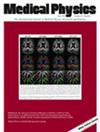Development of patient-specific pre-treatment verification procedure for FLASH proton therapy based on time resolved film dosimetry
Abstract
Background
Pre-clinical studies demonstrate that delivering a high dose at a high dose rate result in less toxicity while maintaining tumor control, known as the FLASH effect. In proton therapy, clinical trials have started using 250 MeV transmission beams and more trials are foreseen. A novel aspect of FLASH treatments, compared to conventional radiotherapy, is the importance of dose rate next to dose and geometry. Therefore, to ensure the safety and quality of FLASH treatments, patient-specific dose-rate verification before treatment is an important additional prerequisite. Various definitions of dose rate have been reported, however, the scanning proton beam (PBS) dose rate definition of Folkerts 2020 is currently the most used. It is the ratio between delta dose (ΔD) and delta time (Δt), subject to a predefined threshold, for a given position. Gafchromic film is a widely available detector used to perform relative and absolute integrated dose measurements. Since the response time of film is in the order of micro seconds it could also be suitable for pre-treatment verification of FLASH proton therapy.
Purpose
Development of a patient-specific pre-treatment verification procedure for FLASH proton therapy based on time resolved film dosimetry. The detector design is presented and validated using three tests.
Methods
A dedicated setup was built that holds a Gafchromic film and a high-speed camera to record the film during the irradiations. The red color channel of the camera's readings was converted into optical density (OD) and an OD-to-dose calibration curve was applied to determine the relative dose accumulation over time. To undo the film measurement (film response) of the post-irradiation coloration process, it is assumed that each dose deposit (pulse) results in a similar film response function. The convolution of the film response function over the pulse provides the film response. First the film response function was obtained by fitting this parameter onto a known film response and corresponding pulse. Post-irradiation coloration correction was performed by deconvoluting all film measurement by the obtained film response function. From the integral of each measured pulse, the Δt was obtained. Several validation tests were conducted: compare the Δt film measurement to a reference detector, exclude that revisiting spots result in an unwanted artefact on the dose accumulation measurement and thereby Δt, and compare Δt distributions of film measurement and simulation (local gamma evaluation, criteria 10%/2 mm) for nine QA fields (dose values; 12, 15, and 20 Gy, and, nozzle currents; 25, 120, and 215 nA). A similar analysis was performed for three dose optimized treatment beams, with and without scan patterns optimized on local dose rate.
Results
Good agreement was found for Δt comparing film to the reference detector, but for Δt values smaller than ∼20 ms the error becomes larger (≥15%). Dose accumulation measured with film over time from a single spot is independent of whether the dose is delivered at once, twice or thrice. All gamma evaluations resulted in a gamma pass rate of ≥90%.
Conclusions
Time resolved film dosimetry to perform patient-specific pre-treatment verification in FLASH proton therapy is feasible.


 求助内容:
求助内容: 应助结果提醒方式:
应助结果提醒方式:


